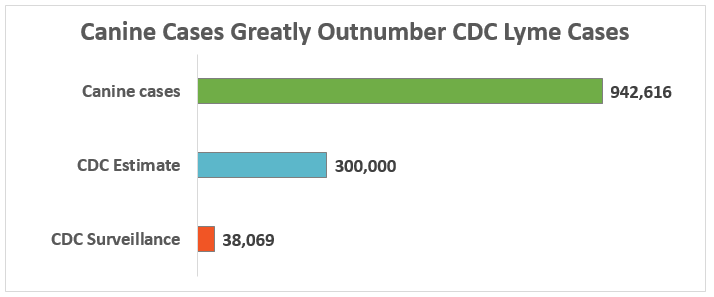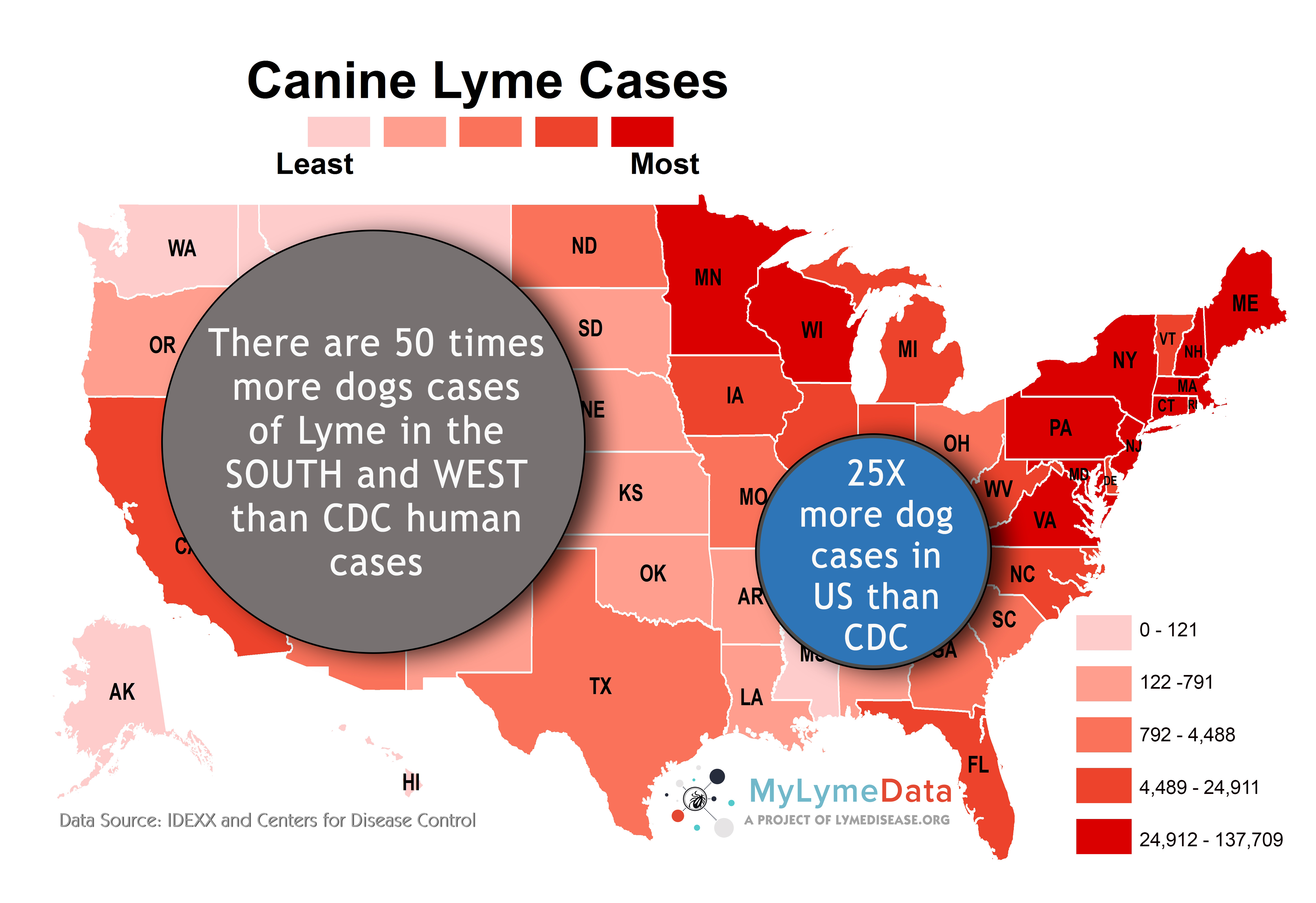LYMEPOLICYWONK: Canine maps predict Lyme disease risk better than the CDC does.

Dogs are considered a good gauge of the exposure of their human owners to infected ticks because they usually share the same environment and visit the same outdoor areas. In other words, canines are considered to be sentinel indicators of Lyme disease risk for humans. Not all dogs who test positive for Lyme antibodies are ill. However, they have been exposed to the Lyme disease bacteria.
A combination of studies out of the Netherlands found that hunters and their hunting dogs had tested positive for Lyme disease at similar rates (17% hunting dogs vs. 15% hunters.)
However, the same study found that pet ownership itself did not increase risk, but that exposure was the primary factor: “Only 12% of the seropositive hunters had hunting dogs which were also seropositive. Moreover, hunters without dog ownership showed no significantly lower rates of seropositivity.”
Unlike people, dogs are routinely screened for Lyme disease and other common co-infections by their vets. IDEXX has tracked Lyme disease and other tick-borne diseases in canines for years by collecting data from veterinarians who test dogs at annual check-ups.
Between 2011 and 2015, IDEXX collected nearly 12 million Lyme disease test results from US veterinarians on a county-by-county basis. The data indicates that Lyme disease is present in abundance in every state in the US.
The number of canine positive test reports is vastly greater than the number of human cases reported by the Centers for Disease Control (CDC). There are close to one million canine positive test results annually in the US, compared to 38,069 cases included in CDC surveillance reports.
This means that there are roughly 25 times more canine cases than CDC surveillance cases. Even taking into account the fact that the CDC acknowledges that surveillance reports significantly underestimate the real incidence of Lyme disease by a factor of 10, the discrepancy is extraordinary. As the chart below reflects, canine cases are still more than three times the number of CDC estimated cases (300,000).
The discrepancy between CDC and canine cases is even more pronounced in the western and southern states. In the West and the South, there are 104,104 cases in dogs annually, compared to 2,342 CDC-reported cases. In other words, there are roughly 50 times more canine cases than CDC surveillance cases.
Michael Yabsley, a parasitologist at the University of Georgia, and Christopher McMahan, an assistant professor of mathematical sciences at Clemson University, have used the IDEXX canine data to develop a risk forecast map for the predicted Lyme disease prevalence — the percentage of dogs who are likely to test positive — by county in each of the 48 contiguous states. Yabsley explains the predictive relationship:
“Dogs really are the canary in the coal mine for human infection. Our research team has evidence that the relationship between canine disease and human disease is strong. Because dogs are being tested for exposure during annual exams, these data are available on a national scale, something that is difficult to get when studying the ticks and environment directly.”
Aside from indicating environmental exposure risk, the data illustrates that people who own pets need to be aware that they face the same exposure when walking their animals or when their animals return home from outdoors carrying ticks. Hence, preventative measures for pets—such as using appropriate tick and flea collars—are essential health matters for both people and their pets to avoid exposure.
LymeDisease.org believes that the IDEXX maps, which track Lyme disease as well as other tick-borne diseases such as ehrlichiosis and anaplasmosis, are the most accurate reflection of exposure. You can type in your zip code in the top right corner to assess your risk here.
For example, in my zip code alone in Los Angeles, 626 cases of canine Lyme disease have been identified. (There are more than 3,500 zip codes in Los Angeles county.) That’s substantially more than the CDC reports for California as a STATE for the last five years (2010-2015).
If you are interested in more information, check out the LymeSci blog on the predictive mapping of canine risk.
The LYME POLICY WONK blog is written by Lorraine Johnson, JD, MBA, who is the Chief Executive Officer of LymeDisease.org. You can contact her at lbjohnson@lymedisease.org. On Twitter, follow her @lymepolicywonk. If you have not signed up for our patient-centered big data project, MyLymeData, please register now.
























Incredible article. Dogs are treated better than humans all around when it comes to TBI’s. My dog tested positive on a yearly exam, got antibiotics for at least a month, and was right as rain. Meanwhile my husband deteriorated year after year – never meeting CDC criteria even at his sickest. The head of the infectious diseases at our local university hospital wouldn’t even see him. He tested positive on the extended Western Blot from Igenex and we found a LLMD who would treat. The take home: you have to find someone who knows what they are doing and realize there is a disconnect within the medical community on TBI’s.
It is pretty clear, especially when you look at the data from other countries, that the prevalence of infection is about 18 to 20% (dogs and humans apparently). The means as many as 50 million Americans could be infected. If that became common knowledge and accepted then 3rd party payers would experience the largest financial hit in their existence and they know it so that would also explain any theories why they might be actively suppressing this understanding.
So, Lyme becomes the negated Pandemic because Pharma has nothing to sell and insurance companies have everything to loose. The information about the extent of this pandemic is being controlled out of the USA and the world follows this insanity.
Dogs who get the Lymes vaccine can test +. This would skew the data significantly. Was this considered when reporting the number?
I was told by my Lyme doctor that my dogs should NOT get the vaccine because I would have a very bad reaction to my dogs??? My dogs are on Frontline for twelve months a year. I spray them and the house with cedar spray. Try the best I can to keep ticks away. Up until I contracted tick borne illnesses, I always had my dogs vaccinated. Any thoughts on this? Was also told NOT to get Flu Shot. Any thoughts on this? Thanks!
I live in Virginia and about 3 years before I fwas diagnosed with Lyme my neighbor’s dog was diagnosed with Lyme. I would walk my dog( he was vaccinated against Lyme) all the time in our neighborhood. Lyme is definitely here in my town. It’s scary!
Yes the tickbourne diseases are everywhere. Lyme, ehrlichia and anaplasma are in the state of New York also.
Great article. Amazing that there is more research occurring in the vet realm than in human, I still believe that our biggest roadblock to moving forward is politics, esp from IDSA. Their position is not tenable and is collapsing with further science. But I am so-o-o impatient for the research “ship” to totally change direction for us. Be sure to catch Dr. Spector’s story and lecture embedded in this article.
Great idea – but the canine data would be much more useful if prevalence was expressed as a % of the at-risk population (or # of cases compared to # of dogs tested). As presented, the county level maps are heavily skewed by population – with few exceptions, prevalence is high in urban counties with large numbers of people (and presumably, dogs). This doesn’t necessarily indicate higher risk, especially since the highest prevalence category is just 85+ cases/county.
I have had Lyme since 2000. No one would test me. Our state was taking the medical licenses away from doctors that tried to treat Lyme. The infectious disease folks at our local university hospital were condescending and said there was no Lyme in Virginia. They have held to this until very recently. Meanwhile the vets were reporting a lot of Lyme in the dogs they see. How could there be no Lyme in Virginia yet the dogs are getting it? I had to go out of state to get any medical help. This whole process has been beyond frustrating and has shown a dark side of medicine.
Unfortunately, we who are suffering from Lyme/Tick Borne Illnesses are allowing the CDC, insurance companies, etc. to treat us in this manner. If there are over 300,000 of us who have TBIs, if we each put in $100, heck, I would put in $1,000! we could sue all of them. I hear very little about TBIs on TV, in newspapers, etc.. Friends who do NOT suffer have pointed this out to me numerous times.